INTRODUCTION AND OVERVIEW
X-ray photons are created by the interaction of energetic electrons with matter at the atomic level. Photons (x-ray and gamma) end their lives by transferring their energy to electrons contained in matter. X-ray interactions are important in diagnostic examinations for many reasons. For example, the selective interaction of x-ray photons with the structure of the human body produces the image; the interaction of photons with the receptor converts an x-ray or gamma image into one that can be viewed or recorded. This chapter considers the basic interactions between x-ray and gamma photons and matter.
X-ray photons are created by the interaction of energetic electrons with matter at the atomic level. Photons (x-ray and gamma) end their lives by transferring their energy to electrons contained in matter. X-ray interactions are important in diagnostic examinations for many reasons. For example, the selective interaction of x-ray photons with the structure of the human body produces the image; the interaction of photons with the receptor converts an x-ray or gamma image into one that can be viewed or recorded. This chapter considers the basic interactions between x-ray and gamma photons and matter.
INTERACTION TYPES
Photon Interactions
Photoelectric
Compton
Coherent Scatter
Pair Production
Electron Interactions
Electron Range
Linear Energy Transfer
Positron Interactions
PHOTON INTERACTION RATES
Attenuation
Linear Attenuation Coefficient
Mass Attenuation Coefficient
Photoelectric Rates
Dependence on Photon Energy
Material Atomic Number
Compton Rates
Direction of Scatter
Energy of Scattered Radiation
COMPETITIVE INTERACTIONS
Photon Interactions
Photoelectric
Compton
Coherent Scatter
Pair Production
Electron Interactions
Electron Range
Linear Energy Transfer
Positron Interactions
PHOTON INTERACTION RATES
Attenuation
Linear Attenuation Coefficient
Mass Attenuation Coefficient
Photoelectric Rates
Dependence on Photon Energy
Material Atomic Number
Compton Rates
Direction of Scatter
Energy of Scattered Radiation
COMPETITIVE INTERACTIONS
Photon Interactions
Recall that photons are individual units of energy. As an x-ray beam or gamma radiation passes through an object, three possible fates await each photon, as shown in the figure below:
1. It can penetrate the section of matter without interacting.
2. It can interact with the matter and be completely absorbed by depositing its energy.
3. It can interact and be scattered or deflected from its original direction and deposit part of its energy.
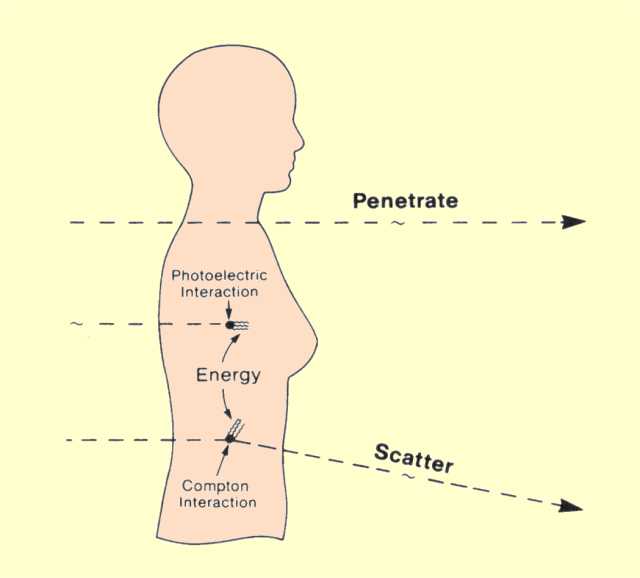
Photons Entering the Human Body Will Either Penetrate, Be Absorbed, or Produce Scattered Radiation
There are two kinds of interactions through which photons deposit their energy; both are with electrons. In one type of interaction the photon loses all its energy; in the other, it loses a portion of its energy, and the remaining energy is scattered. These two interactions are shown below.
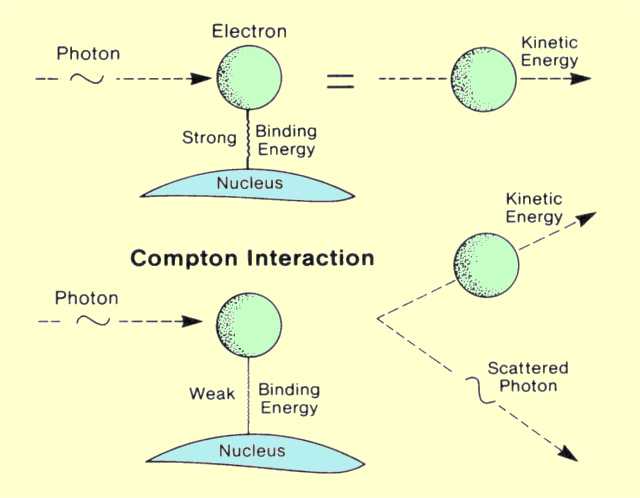
The Two Basic Interactions Between Photons and Electrons
Photoelectric effect
In the photoelectric (photon-electron) interaction, as shown above, a photon transfers all its energy to an electron located in one of the atomic shells. The electron is ejected from the atom by this energy and begins to pass through the surrounding matter. The electron rapidly loses its energy and moves only a relatively short distance from its original location. The photon's energy is, therefore, deposited in the matter close to the site of the photoelectric interaction. The energy transfer is a two-step process. The photoelectric interaction in which the photon transfers its energy to the electron is the first step. The depositing of the energy in the surrounding matter by the electron is the second step.
Photoelectric interactions usually occur with electrons that are firmly bound to the atom, that is, those with a relatively high binding energy. Photoelectric interactions are most probable when the electron binding energy is only slightly less than the energy of the photon. If the binding energy is more than the energy of the photon, a photoelectric interaction cannot occur. This interaction is possible only when the photon has sufficient energy to overcome the binding energy and remove the electron from the atom.
The photon's energy is divided into two parts by the interaction. A portion of the energy is used to overcome the electron's binding energy and to remove it from the atom. The remaining energy is transferred to the electron as kinetic energy and is deposited near the interaction site. Since the interaction creates a vacancy in one of the electron shells, typically the K or L, an electron moves down to fill in. The drop in energy of the filling electron often produces a characteristic x-ray photon. The energy of the characteristic radiation depends on the binding energy of the electrons involved. Characteristic radiation initiated by an incoming photon is referred to as fluorescent radiation. Fluorescence, in general, is a process in which some of the energy of a photon is used to create a second photon of less energy. This process sometimes converts x-rays into light photons. Whether the fluorescent radiation is in the form of light or x-rays depends on the binding energy levels in the absorbing material.
Compton
A Compton interaction is one in which only a portion of the energy is absorbed and a photon is produced with reduced energy. This photon leaves the site of the interaction in a direction different from that of the original photon, as shown in the previous figure. Because of the change in photon direction, this type of interaction is classified as a scattering process. In effect, a portion of the incident radiation "bounces off' or is scattered by the material. This is significant in some situations because the material within the primary x-ray beam becomes a secondary radiation source. The most significant object producing scattered radiation in an x-ray procedure is the patient's body. The portion of the patient's body that is within the primary x-ray beam becomes the actual source of scattered radiation. This has two undesirable consequences. The scattered radiation that continues in the forward . direction and reaches the image receptor decreases the quality (contrast) of the image; the radiation that is scattered from the patient is the predominant source of radiation exposure to the personnel conducting the examination.
Coherent Scatter
There are actually two types of interactions that produce scattered radiation. One type, referred to by a variety of names, including coherent, Thompson, Rayleigh, classical, and elastic, is a pure scattering interaction and deposits no energy in the material. Although this type of interaction is possible at low photon energies, it is generally not significant in most diagnostic procedures.
Pair Production
Pair production is a photon-matter interaction that is not encountered in diagnostic procedures because it can occur only with photons with energies in excess of 1.02 MeV. In a pair-production interaction, the photon interacts with the nucleus in such a manner that its energy is converted into matter. The interaction produces a pair of particles, an electron and a positively charged positron. These two particles have the same mass, each equivalent to a rest mass energy of 0.51 MeV.
Electron Range
The total distance an electron travels in a material before losing all its energy is generally referred to as its range. The two factors that determine the range are (1) the initial energy of the electrons and (2) the density of the material. One important characteristic of electron interactions is that all electrons of the same energy have the same range in a specific material, as illustrated immediately below. The general relationship between electron range and energy is shown in the second following figure. The curve shown is the range for a material with a density of 1 g/cm3. This is the density of water and the approximate density of muscle tissue.
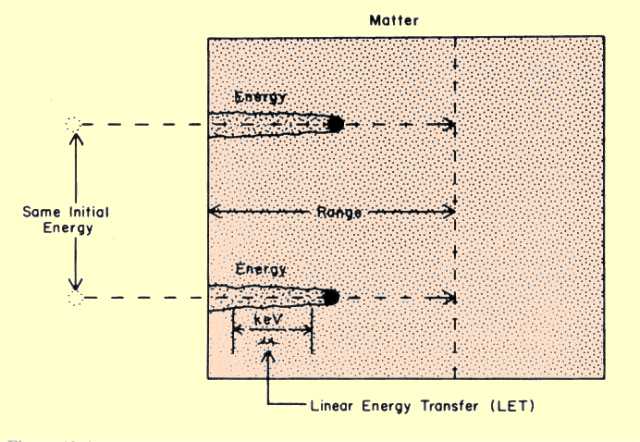
The Range of Electrons with the Same Initial Energies
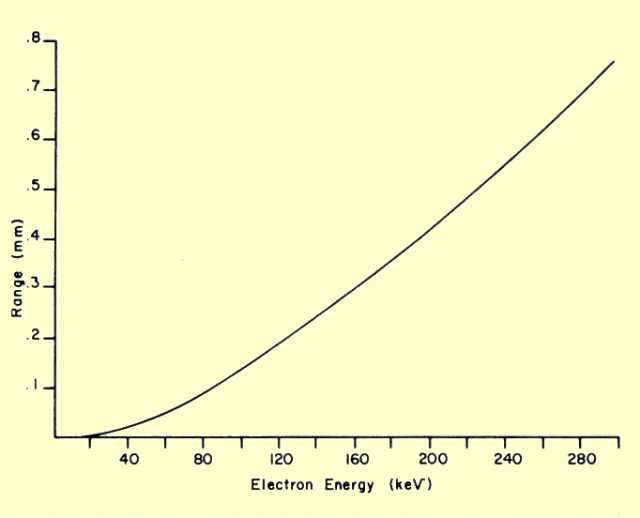
Relationship of Electron Range to Initial Energy in a Material with a Density of 1 g/cm3 (Soft Tissue)
The electron range in other materials can be determined by dividing the range given in the figure above by the density of the material. Let us now apply this procedure to determine the range of 300-keV beta particles in air. (Air has a density of 0.00129 g/cm3.) From the figure we see that a 300-keV electron has a range of 0.76 mm in a material with a density of 1 g/cm3. When this value is divided by the density of air, we find the range to be 59 cm.
In general, the range of electron radiation in materials such as tissue is a fraction of a millimeter. This means that essentially all electron radiation energy is absorbed in the body very close to the site containing the radioactive material.
Linear Energy Transfer
The rate at which an electron transfers energy to a material is known as the linear energy transfer (LET), and is expressed in terms of the amount of energy transferred per unit of distance traveled. Typical units are kiloelectron volts per micrometer (keV/um). In a given material, such as tissue, the LET value depends on the kinetic energy (velocity) of the electron. The LET is generally inversely related to the electron velocity. As a radiation electron loses energy, its velocity decreases, and the value of the LET increases until all its energy is dissipated. LET values in soft tissue for several electron energies are given below.
The effectiveness of a particular radiation in producing biological damage is often related to the LET of the radiation. The actual relationship of the efficiency in producing damage to LET values depends on the biological effect considered. For some effects, the efficiency increases with an increase in LET, for some it decreases, and for others it increases up to a point and then decreases with additional increases in LET. For a given biological effect, there is an LET value that produces an optimum energy concentration within the tissue. Radiation with lower LET values does not produce an adequate concentration of energy. Radiations with higher LET values tend to deposit more energy than is needed to produce the effect; this tends to waste energy and decrease efficiency.
Positron Interactions
Recall that a positron is the same size as an electron, but has a positive charge. It is also different from the electron in that it is composed of what is referred to as antimatter. This leads to a type of interaction that is quite different from the interactions among electrons.
The interaction between a positron and matter is in two phases, as illustrated below. These are ionization and annihilation. As the energetic positron passes through matter, it interacts with the atomic electrons by electrical attraction. As the positron moves along, it pulls electrons out of the atoms and produces ionization. A small amount of energy is lost by the positron in each interaction. In general, this phase of the interaction is not too unlike the interaction of an energetic electron, but the positron pulls electrons as it races by and electrons push electrons away-from the path. Also, when the positron has lost most of its kinetic energy and is coming to a stop, it comes into close contact with an electron and enters into an annihilation interaction.
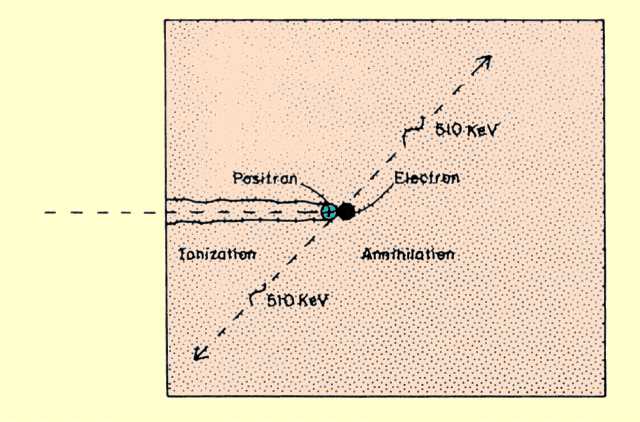
A Positron Interaction That Produces Annihilation Radiation
The annihilation process occurs when the antimatter positron combines with the conventional-matter electron. In this interaction, the masses of both particles are completely converted into energy. The relationship between the amount of energy and mass is given by
E= mc2.
The energy equivalent of one electron or positron mass is 511 keV. The energy that results from the annihilation process is emitted from the interaction site in the form of two photons, each with an energy of 511 keV. The pair of photons leave the site in opposite directions. With special imaging equipment it is possible to capture both photons and to determine the precise three-dimensional location of the interaction site. Since the range of a positron, like that of an electron, is relatively short, the site of interaction is always very close to the location of the radioactive nuclei.
Recall that photons are individual units of energy. As an x-ray beam or gamma radiation passes through an object, three possible fates await each photon, as shown in the figure below:
1. It can penetrate the section of matter without interacting.
2. It can interact with the matter and be completely absorbed by depositing its energy.
3. It can interact and be scattered or deflected from its original direction and deposit part of its energy.

Photons Entering the Human Body Will Either Penetrate, Be Absorbed, or Produce Scattered Radiation
There are two kinds of interactions through which photons deposit their energy; both are with electrons. In one type of interaction the photon loses all its energy; in the other, it loses a portion of its energy, and the remaining energy is scattered. These two interactions are shown below.

The Two Basic Interactions Between Photons and Electrons
Photoelectric effect
In the photoelectric (photon-electron) interaction, as shown above, a photon transfers all its energy to an electron located in one of the atomic shells. The electron is ejected from the atom by this energy and begins to pass through the surrounding matter. The electron rapidly loses its energy and moves only a relatively short distance from its original location. The photon's energy is, therefore, deposited in the matter close to the site of the photoelectric interaction. The energy transfer is a two-step process. The photoelectric interaction in which the photon transfers its energy to the electron is the first step. The depositing of the energy in the surrounding matter by the electron is the second step.
Photoelectric interactions usually occur with electrons that are firmly bound to the atom, that is, those with a relatively high binding energy. Photoelectric interactions are most probable when the electron binding energy is only slightly less than the energy of the photon. If the binding energy is more than the energy of the photon, a photoelectric interaction cannot occur. This interaction is possible only when the photon has sufficient energy to overcome the binding energy and remove the electron from the atom.
The photon's energy is divided into two parts by the interaction. A portion of the energy is used to overcome the electron's binding energy and to remove it from the atom. The remaining energy is transferred to the electron as kinetic energy and is deposited near the interaction site. Since the interaction creates a vacancy in one of the electron shells, typically the K or L, an electron moves down to fill in. The drop in energy of the filling electron often produces a characteristic x-ray photon. The energy of the characteristic radiation depends on the binding energy of the electrons involved. Characteristic radiation initiated by an incoming photon is referred to as fluorescent radiation. Fluorescence, in general, is a process in which some of the energy of a photon is used to create a second photon of less energy. This process sometimes converts x-rays into light photons. Whether the fluorescent radiation is in the form of light or x-rays depends on the binding energy levels in the absorbing material.
Compton
A Compton interaction is one in which only a portion of the energy is absorbed and a photon is produced with reduced energy. This photon leaves the site of the interaction in a direction different from that of the original photon, as shown in the previous figure. Because of the change in photon direction, this type of interaction is classified as a scattering process. In effect, a portion of the incident radiation "bounces off' or is scattered by the material. This is significant in some situations because the material within the primary x-ray beam becomes a secondary radiation source. The most significant object producing scattered radiation in an x-ray procedure is the patient's body. The portion of the patient's body that is within the primary x-ray beam becomes the actual source of scattered radiation. This has two undesirable consequences. The scattered radiation that continues in the forward . direction and reaches the image receptor decreases the quality (contrast) of the image; the radiation that is scattered from the patient is the predominant source of radiation exposure to the personnel conducting the examination.
Coherent Scatter
There are actually two types of interactions that produce scattered radiation. One type, referred to by a variety of names, including coherent, Thompson, Rayleigh, classical, and elastic, is a pure scattering interaction and deposits no energy in the material. Although this type of interaction is possible at low photon energies, it is generally not significant in most diagnostic procedures.
Pair Production
Pair production is a photon-matter interaction that is not encountered in diagnostic procedures because it can occur only with photons with energies in excess of 1.02 MeV. In a pair-production interaction, the photon interacts with the nucleus in such a manner that its energy is converted into matter. The interaction produces a pair of particles, an electron and a positively charged positron. These two particles have the same mass, each equivalent to a rest mass energy of 0.51 MeV.
Electron Range
The total distance an electron travels in a material before losing all its energy is generally referred to as its range. The two factors that determine the range are (1) the initial energy of the electrons and (2) the density of the material. One important characteristic of electron interactions is that all electrons of the same energy have the same range in a specific material, as illustrated immediately below. The general relationship between electron range and energy is shown in the second following figure. The curve shown is the range for a material with a density of 1 g/cm3. This is the density of water and the approximate density of muscle tissue.

The Range of Electrons with the Same Initial Energies

Relationship of Electron Range to Initial Energy in a Material with a Density of 1 g/cm3 (Soft Tissue)
The electron range in other materials can be determined by dividing the range given in the figure above by the density of the material. Let us now apply this procedure to determine the range of 300-keV beta particles in air. (Air has a density of 0.00129 g/cm3.) From the figure we see that a 300-keV electron has a range of 0.76 mm in a material with a density of 1 g/cm3. When this value is divided by the density of air, we find the range to be 59 cm.
In general, the range of electron radiation in materials such as tissue is a fraction of a millimeter. This means that essentially all electron radiation energy is absorbed in the body very close to the site containing the radioactive material.
Linear Energy Transfer
The rate at which an electron transfers energy to a material is known as the linear energy transfer (LET), and is expressed in terms of the amount of energy transferred per unit of distance traveled. Typical units are kiloelectron volts per micrometer (keV/um). In a given material, such as tissue, the LET value depends on the kinetic energy (velocity) of the electron. The LET is generally inversely related to the electron velocity. As a radiation electron loses energy, its velocity decreases, and the value of the LET increases until all its energy is dissipated. LET values in soft tissue for several electron energies are given below.
The effectiveness of a particular radiation in producing biological damage is often related to the LET of the radiation. The actual relationship of the efficiency in producing damage to LET values depends on the biological effect considered. For some effects, the efficiency increases with an increase in LET, for some it decreases, and for others it increases up to a point and then decreases with additional increases in LET. For a given biological effect, there is an LET value that produces an optimum energy concentration within the tissue. Radiation with lower LET values does not produce an adequate concentration of energy. Radiations with higher LET values tend to deposit more energy than is needed to produce the effect; this tends to waste energy and decrease efficiency.
Positron Interactions
Recall that a positron is the same size as an electron, but has a positive charge. It is also different from the electron in that it is composed of what is referred to as antimatter. This leads to a type of interaction that is quite different from the interactions among electrons.
The interaction between a positron and matter is in two phases, as illustrated below. These are ionization and annihilation. As the energetic positron passes through matter, it interacts with the atomic electrons by electrical attraction. As the positron moves along, it pulls electrons out of the atoms and produces ionization. A small amount of energy is lost by the positron in each interaction. In general, this phase of the interaction is not too unlike the interaction of an energetic electron, but the positron pulls electrons as it races by and electrons push electrons away-from the path. Also, when the positron has lost most of its kinetic energy and is coming to a stop, it comes into close contact with an electron and enters into an annihilation interaction.

A Positron Interaction That Produces Annihilation Radiation
The annihilation process occurs when the antimatter positron combines with the conventional-matter electron. In this interaction, the masses of both particles are completely converted into energy. The relationship between the amount of energy and mass is given by
E= mc2.
The energy equivalent of one electron or positron mass is 511 keV. The energy that results from the annihilation process is emitted from the interaction site in the form of two photons, each with an energy of 511 keV. The pair of photons leave the site in opposite directions. With special imaging equipment it is possible to capture both photons and to determine the precise three-dimensional location of the interaction site. Since the range of a positron, like that of an electron, is relatively short, the site of interaction is always very close to the location of the radioactive nuclei.



